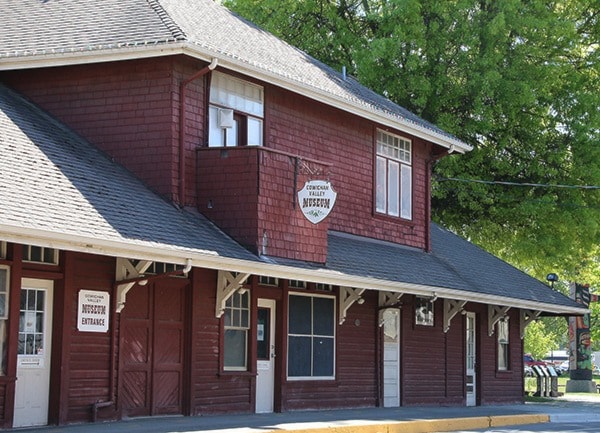Treasure, like beauty, can be in the eye of the beholder. For me (you’ve probably noticed), treasure is our history. It’s all around us. But if you want to cut to the quick and dig deeper, there’s no better way to do so than to visit our local museums.
In Duncan, we have a bonus: not just the Cowichan Valley Museum in the heritage railway station but the archives, operated by the CVM on the top floor of city hall. Here’s where you can strike gold by the bushelful.
I could expound at length on the treasures contained therein but for today I’ll stick to one that particularly pleases me. I’m a sucker for autobiographies and memoirs — stories told by the very person(s) who experienced them. Some firsthand accounts may be egocentric and untruthful to some degree but that doesn’t detract from the fact that they’re sharing with you their very own personal viewpoint. In reading their accounts you’re seeing the world as it was through their eyes.
I’ll give this great for-instance, excerpts from a letter written by the late Ernest Corfield. He’s writing of “the old days...possibly in the 1950s” as has been noted on the file copy by an archivist. Some will remember the Corfield brothers as proprietors of Duncan Garage, which, happily, is still with us on Duncan Street. That’s not the case, alas, for the Corfield manor on the Cowichan Bay Flats, which burned down with great financial loss in 1920.
But let’s get back to Ernest’s recollections. Referring to his father, George Treffry Corfield, he tells how the patriarch of the Cowichan Corfields first worked in the West Indies, “in charge of a gang of negroes or natives mining and loading ships with guano. I believe he always carried a couple of revolvers with him.”
How’s that for a dramatic start? It gets better: “He had a large packing case which he always kept locked in his bedroom in the old farmhouse and in this I believe he kept the revolvers and treasures from the West Indies. This is the trunk he and Norman tried to save when he was so badly burned in the disastrous fire of May 16, 1920...”
This family tragedy was compounded, four months later to the day, by the death of G.T.’s wife (Ernest’s mother), Christiana, aged 65.
“Father also farmed the old Pimbury farm [I’m cherry picking—TW] until it was sold to the Jeffrey family about 1904 or 1905. I am guessing at this date as the [South Cowichan Lawn Tennis Club] moved from the Pimbury property and the new courts on our property opened about 1906 and I was Secretary and Groundsman for about 7 years, starting about 1909 or 1910. Father also operated the Marriner farm until about 1920...
“I have a dim recollection of all the cows and oxen being driven in an open barn and some of the cows being milked on arrival. I also remember a trip we made to that farm with a single horse and buggy with Mother driving and 6 or 7 children packed in, with me on the floor under the back seat and on the way home, coming down the long hill, the hold-back straps broke and the horse bolted and we all landed with buggy upside down on the beach and the horse, Polly, broke away and headed for home. And, later, Father arriving in a terrible temper with a team of horses and carriage, one of the team being the one that ran away.”
There was further adventure in the young Ernest Corfield’s life at Cowichan Bay, from his being run over by a gravel cart, which broke his arm, to the attempted kidnapping of a younger brother: “I can well remember playing out on the road in front of the old store one morning when I was about 5 or 6, with Walter, who was just able to walk, when an old Indian woman came along and picked Walter up and tucked him under her shawl and made off for the reserve, leaving me screaming for all I was worth until Ernest Leakey [the storekeeper] came to the rescue, and by the time he caught up with her, she was just passing where the tennis courts are now...”
For that matter, everyday life on the Corfield farm sounds fascinating: “One thing that may seem strange...is that for many years a very large crate of clothing was shipped to a Chinese laundry in Victoria once every week, and for years we used to look forward to the Chinese New Year when the laundry box would come back filled with fire crackers, ginger, leichie [sic] nuts, etc., and some for everyone of the family, with special bulbs for Mother...”
There’s more — and he’s just working up to his childhood memories of a young Corfield employee named Robert Service who used to thrill them with the “wild...and most blood-thirsty stories he could think up”. This, of course, was before he went to work for a bank in Victoria, was posted to the Dawson City branch and became known internationally as the Bard of the Yukon.
If you’d like to know more about the historic Corfield family at Cowichan Bay and their involvement with Duncan Garage, the city’s pioneer Ford auto dealership, why not visit the Cowichan Valley Archives? It’s open, by appointment through the museum, Wednesdays through Fridays, and well worth a visit. Tell them TW sent you.
www.twpaterson.com
